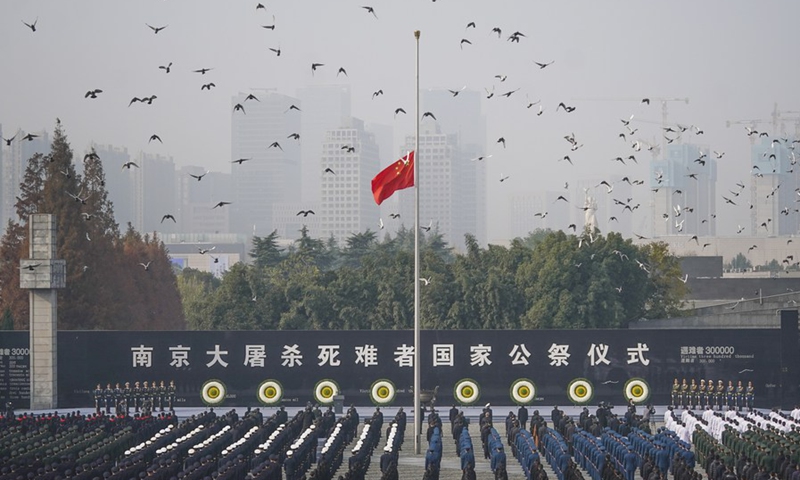
Photo taken on Dec. 13, 2020 shows the national memorial ceremony for the Nanjing Massacre victims at the Memorial Hall of the Victims of the Nanjing Massacre by Japanese Invaders in Nanjing, capital of east China's Jiangsu Province.(Photo: Xinhua)
It's another August 15th. Surprisingly and unsurprisingly, Japanese leaders did not mention or reflect upon anything the Japanese militants had done to the neighboring countries in their speech on the anniversary of Japanese surrender in WWII. At the same time, Yasukuni Shrine visits by Japanese politicians have been ceaseless, despite furious protests from neighboring countries. In China, an actor came under fire for posting a photo of himself smiling in front of the Yasukuni Shrine.
For those who are not familiar with this period of history, some foreigners might wonder: what does the shrine stand for and why are the Chinese so serious about that? What's exactly inside the shrine?
Well, the answer is drenched in blood.
In WWII, the Japanese militants launched its aggression against China from 1931 to 1945, killing and injuring over 35 million Chinese while committing countless human right abuses, including rape, mass incarceration, torture, bacterial experiment. Japanese commanders and soldiers who had behaved like demons yet ended up at a place to let their cursed soul rest in worship.
The Yasukuni Shrine commemorates over 1,000 Japanese WWII war criminals, 14 of whom are A-Class. Out of the 2.46 million listed in the shrine, more than 94% died in the invasive actions conducted by the Japanese government in China and the pacific region during WWII. What is shockingly presented in the shrine is that the Japanese government doesn't even care about compensating for their crimes but try to beautify its invasion through word-plays, particularly in the Yasukuni Shrine and its museum, the Yushukan Museum.
According to the introduction of the museum, the September 18th Incident in 1931, marking the beginning of the Japanese invasion against China, was the result that "Chinese soldiers and civilians were strongly against Japan, and Japanese there were living in tears".
The Nanjing Massacre, in which 300,000 Chinese were killed, took place because "the Chinese soldiers disguised in civilian clothes were severely prosecuted".
The Japanese military occupation all over Asian countries even "contributed to their independence". "Once the desire for independence had been kindled under Japanese occupation, it did not fade away, even though Japan was ultimately defeated. Asian nations fought for their independence, and achieved triumph".
Throughout the museum, numerous war-related items are exhibited to show the mightiness of Japan's military power and praise its soldiers for the "noble contributions" to the imperialist cause while shedding crocodile's tears about the cruelty of warfare.
These remarks are utterly shameless. The only explanation is that the Japanese government does not find itself guilty at all. Evidence is that outside the museum stands the statue of Justice Radhabinod Pal from India, the only justice in the Tokyo Trial that asserted the accused Japanese militants not guilty. Mr. Pal is remembered by the Japanese government for bringing them "peace and justice", and more importantly, a chance to whitewash their crimes.
Owing to the irresponsible attitude of the Japanese government, such denial of history has mislead some people. But such a ploy cannot deceive its neighboring countries and international community. People are never numb about the Japanese's wrongdoings. On Tripadvisor.com:
"Unless you are a right-wing apologist or completely ignorant of the history of this place, avoid at all cost"
"The museum really tries to minimize the wrong doing of Japan during WWII"
"Don't expect any introspection about the Imperial Army's conduct in WWII"
That is why the Yasukuni Shrine remains an extremely sensitive issue, and why China, together with all the other suffering countries and victims, protest over and over again. We can't bury history in ashes, nor are we supposed to allow it to repeat itself.
(The author is a commentator on international affairs, writing regularly for Global Times, China Daily etc.. He can be reached at xinping604@gmail.com.)
